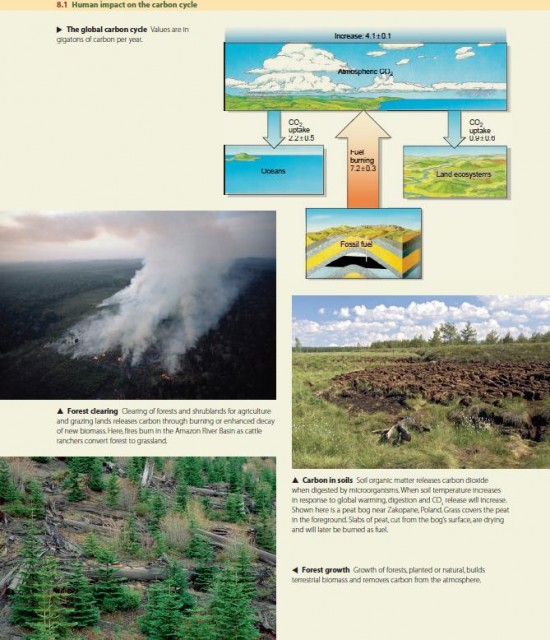Human Impact on the Carbon Cycle
Carbon is an element that is abundant at the Earth's surface and is also essential for life. Carbon cycles continuously among the land surface, atmosphere, and ocean in many complex pathways. However, these flows are now strongly influenced by human activity. The most important human impact on the carbon cycle is the burning of fossil fuels, which releases carbon dioxide (CO2) into the atmosphere and enhances global warming. Another important human impact lies in changing the Earth's land covers—for example, in clearing forests or abandoning agricultural areas—which can release or take up atmospheric CO2. Let's look at these impacts in more detail.
Figure 8.1 shows a simple diagram of the global atmospheric carbon budget for the period 2000–2005. The magnitudes of the annual flows are shown in gigatons (Gt) of carbon per year (1 gigaton = 109 metric tons = 1012 kg = 1.1 ? 109 English tons = 1.1 English gigatons). These flows are estimates, and a second value after the first indicates its uncertainty.

Fossil fuel burning contributes about 7.2 ± 0.3 Gt of carbon per year, nearly all in the form of carbon dioxide. About 2.2 ± 0.5 Gt of carbon per year is taken up by the oceans, reducing the atmospheric content by that amount. In addition, yearly uptake of carbon dioxide by land ecosystems is estimated at about 0.9 ± 0.6 Gt of carbon. Taken together, these two flows out of the atmosphere leave about 4.1 ± 0.1 Gt of additional carbon r emaining in the atmosphere each year.
Two processes are responsible for the uptake of carbon by the oceans. First, carbon dioxide dissolves in sea water, which removes carbon from the atmosphere. Second, phytoplankton—microscopic plants living in the ocean—take up carbon dioxide in photosynthesis. When they die, they produce organic matter that sinks to the ocean floor, removing it from short-term circulation. The removal of carbon dioxide is moderated somewhat by another process in which the formation of calcium carbonate by diatoms and other marine organisms releases CO2. Taken together, these oceanic processes remove about 30 percent of the carbon released to the atmosphere each year by fossil fuel burning.
Land ecosystems cycle carbon by photosynthesis, respiration, decomposition, and combustion. Photosynthesis and respiration are basic physiological processes of plants that absorb CO2 from the atmosphere and release it, respectively. Decomposition is the process in which bacteria and fungi digest dead organic matter, and is actually a form of respiration. Combustion refers to uncontrolled combustion, as when an ecosystem burns in a forest fire.
These processes, taken as a whole, remove about 0.9 Gt of carbon per year from the atmosphere—about 12 percent of the contribution of fossil fuel burning. This uptake of atmospheric CO2 by land ecosystems means that plant biomass—the amount of carbon-bearing material contained in living and dead plant matter—is increasing at that rate. However, forests are presently diminishing in area as they are logged or converted to farmland or grazing land. This conversion is primarily occurring in tropical and equatorial regions, and it is estimated to release about 1.6 Gt of carbon per year (1990s estimate) to the atmosphere. If this large amount is being released, then the remaining area of land ecosystems must be taking up at least that much carbon, and more—totaling about 2.5 Gt per year—to provide a net uptake of 0.9 Gt/yr.
Independent evidence seems to confirm this conclusion. In Europe, for example, forest statistics show an increase of growing stock—the volume of living trees—of at least 25 percent since 1970. In North America, forest areas are increasing in many regions as agricultural production has abandoned marginal areas to natural forest regrowth. New England is a good example of this trend.
A century ago, only a small portion of New England was forested. Now only a small portion is cleared.
Some of the increase in global biomass may also be due to warmer temperatures and increased atmospheric CO2 concentrations, which enhance photosynthesis to make plants more productive. Another stimulating factor is nitrogen fertilization of soils by the washout of nitrogen pollutant gases in the atmosphere.
While the dynamics of forests are important in the global carbon cycle, soils may be even more important. Recent inventories estimate that about four times as much carbon resides in soils than in above-ground plant biomass. The largest reservoir of soil carbon is in the boreal forest. In fact, there is about as much carbon in boreal forest soils as in all above-ground vegetation.
This soil carbon has accumulated over thousands of years under cold conditions that have retarded its decay. However, there is now great concern that global warming, which is acting more strongly at high latitudes, will increase the rate of decay of this vast carbon pool, releasing CO2 as microorganisms digest the organic matter. Boreal forests, which are presently taking up CO2, may soon start releasing it, causing even more warming.
Figure 8.1 shows some terrestrial sources and sinks of carbon, including soil organic matter. Reducing the rate of carbon dioxide buildup in the atmosphere is a matter of great international concern. As we noted in Chapter 3, the world's nations have been struggling to implement a plan to control these emissions. While much good progress has been made, more work is needed. An effective global commitment to reduction of CO2 releases and control of global warming still awaits us.